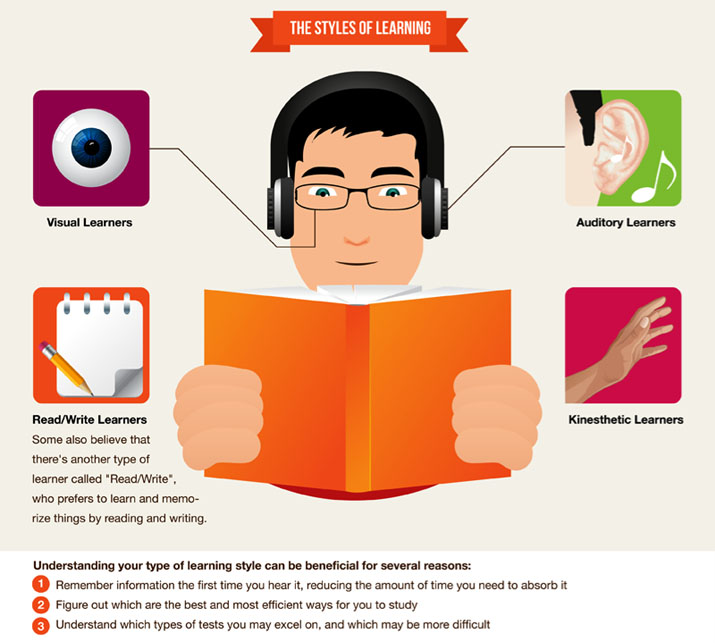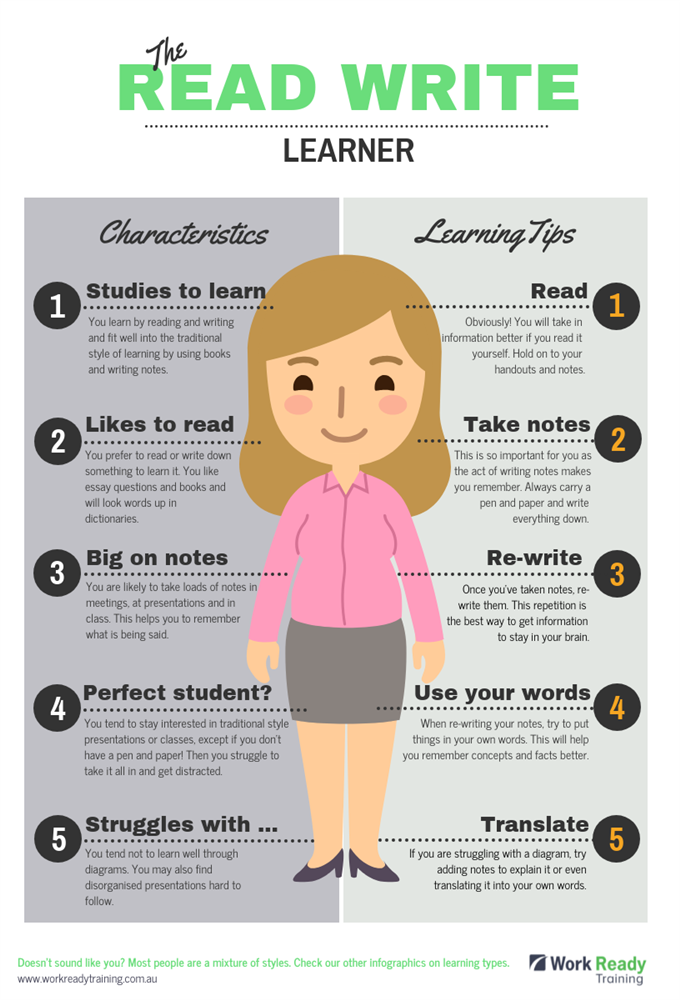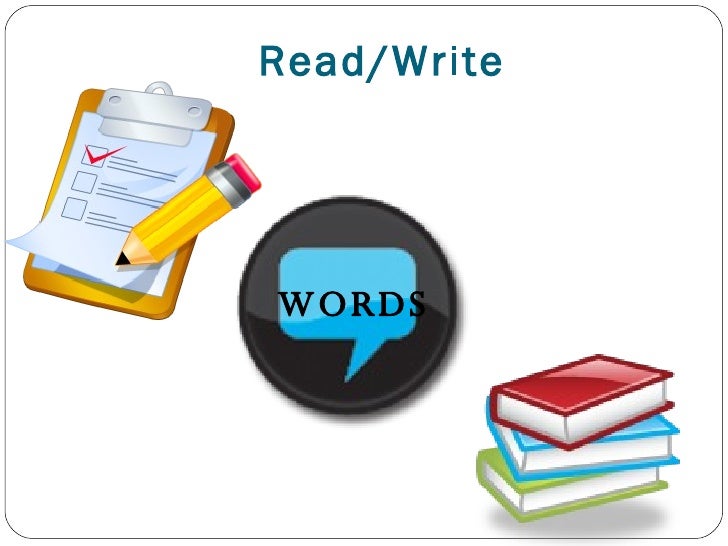Read Write Learning Style
Read Write Learning Style - Do well with multiple choice and essay tests; Web there are four main types of learners: You place a lot of importance on taking in written information about concepts, person, or processes before you can reach a decision. Then, when you get home, rewrite the notes in your own words (every time you write the notes, you’re. The current vark model stands for four types of learner: Visual, aural, reading/writing, and kinesthetic. Web our expert tutors are able to adapt their teaching styles to your child and the way that they learn best. Web to take in information: We’ll discuss the best ways to effectively teach these students, and we’ll reveal common pitfalls that teachers should avoid. Visual, reading/writing, auditory, and kinesthetic.
The idea of learning styles has been studied since the 1980s; Web what is a read/write, linguistic, or verbal learner? In the classroom, write all of the notes verbatim; Web what is a read/write learning style? Web try some of the following to make the most of your learning style: Visual, auditory, reading/writing, and kinesthetic. Web our expert tutors are able to adapt their teaching styles to your child and the way that they learn best. Web variously leaners may have multiple learning preferences and may do well with both verbal learning how and visual learning tools. Learn best by reading and rereading the textbook or their notes, writing. Visual, aural, reading/writing, and kinesthetic.
Read/write learners = you like this page because the emphasis is on words and lists. They're often good at summarizing information in written notes. If you have a strong preference for read/write (r) learning… We’ll discuss the best ways to effectively teach these students, and we’ll reveal common pitfalls that teachers should avoid. Visual, reading/writing, auditory, and kinesthetic. Web what is a read/write learning style? Do well with multiple choice and essay tests; Visual, auditory, reading/writing, and kinesthetic. Web below we take a closer look at the reading and writing learning style. Use dictionaries and glossaries, and articles about trends in.
4 Types of Learning Styles How Do Students Learn Best? BAU
Do well with multiple choice and essay tests; Visual, auditory, reading/writing, and kinesthetic. Visual, auditory, reading/writing, and kinesthetic. They're often good at summarizing information in written notes. Many learners show strength in more than one learning style.
Tools to Improve Communication, Reading, Memory and More For All
Visual, auditory, reading/writing, and kinesthetic. If you have a strong preference for read/write (r) learning… They’re the type of students who don’t mind sitting down and reading through a textbook to gain. Web read/write learners are typically the students who excel by using traditional study methods. Use dictionaries and glossaries, and articles about trends in.
Work Ready Training. What's your learning style Read write learner?
Use dictionaries and glossaries, and articles about trends in. Neil fleming, who developed the vark classification system for learning styles, introduced the read/write learning style as the style that preferred the printed word for learning. Visual, aural, reading/writing, and kinesthetic. Visual, auditory, reading/writing, and kinesthetic. Studies show that an estimated 89% of teachers believe in matching instruction to a student’s.
Reading And Writing Clipart Read Write Vark Learning Styles 640x480
Many learners show strength in more than one learning style. Web vark learning styles suggest that there are four main types of learners: Web the vark system categorizes learners into four styles: In the classroom, write all of the notes verbatim; If you have a strong preference for read/write (r) learning…
Students have different learning style preferences. While some are
Learn best by reading and rereading the textbook or their notes, writing. You place a lot of importance on taking in written information about concepts, person, or processes before you can reach a decision. Web knowing your child’s learning style will help you to plan activities in a way that is sure to have a meaningful, lasting effect. Web try.
Learning Style
Web what is a read/write learning style? Do well with multiple choice and essay tests; They’ll get to know your child’s reading and writing learning style, and help them develop strong learning and. Web variously leaners may have multiple learning preferences and may do well with both verbal learning how and visual learning tools. Neil fleming, who developed the vark.
Discovering & Developing Your Children's Homeschool Learning Styles
Web to take in information: Read/write learning style means that when you need to be convinced of something, you’d prefer to read it on a page or a screen. Use lists (like this one!) use titles and headings that clearly explain what follows. There are many specific characteristics of read/write learners including: Web below we take a closer look at.
Design Learner's Bubble
This doesn’t mean you need to read a book to learn. Web what is a read/write learning style? You place a lot of importance on taking in written information about concepts, person, or processes before you can reach a decision. Web the concept of “learning styles” has been overwhelmingly embraced by educators in the u.s. The idea of learning styles.
4 Different Types of Learners Which one are you? InfoDepot Blog
We’ll discuss the best ways to effectively teach these students, and we’ll reveal common pitfalls that teachers should avoid. Visual, aural, reading/writing, and kinesthetic. In the classroom, write all of the notes verbatim; You believe the meanings are within the words, so the talk was ok, but a handout is better. Web the vark system categorizes learners into four styles:
6 Techniques for Building Reading Skills—in Any Subject Edutopia
Web characteristics of the read/write learning style. The idea that students learn best when teaching methods and school activities match their learning styles… Though you might be more than one type of learner depending on the subject matter, here are ways to identify how you learn best and how to apply your learning style. Visual, auditory, reading/writing, and kinesthetic. Studies.
You Place A Lot Of Importance On Taking In Written Information About Concepts, Person, Or Processes Before You Can Reach A Decision.
Studies show that an estimated 89% of teachers believe in matching instruction to a student’s preferred learning style. They’re the type of students who don’t mind sitting down and reading through a textbook to gain. Do well with multiple choice and essay tests; Web characteristics of the read/write learning style.
They Do Well By Using The Traditional Study Method Of Reading From A Textbook And Taking Notes, And Prefer To Learn.
They're often good at summarizing information in written notes. Visual, auditory, reading/writing, and kinesthetic. Web knowing your child’s learning style will help you to plan activities in a way that is sure to have a meaningful, lasting effect. This doesn’t mean you need to read a book to learn.
In The Classroom, Write All Of The Notes Verbatim;
Visual, auditory, reading/writing, and kinesthetic. The idea of learning styles has been studied since the 1980s; We’ll discuss the best ways to effectively teach these students, and we’ll reveal common pitfalls that teachers should avoid. Web vark learning styles suggest that there are four main types of learners:
Neil Fleming, Who Developed The Vark Classification System For Learning Styles, Introduced The Read/Write Learning Style As The Style That Preferred The Printed Word For Learning.
Use dictionaries and glossaries, and articles about trends in. The current vark model stands for four types of learner: Read/write learners = you like this page because the emphasis is on words and lists. Web read/write learners are typically the students who excel by using traditional study methods.









